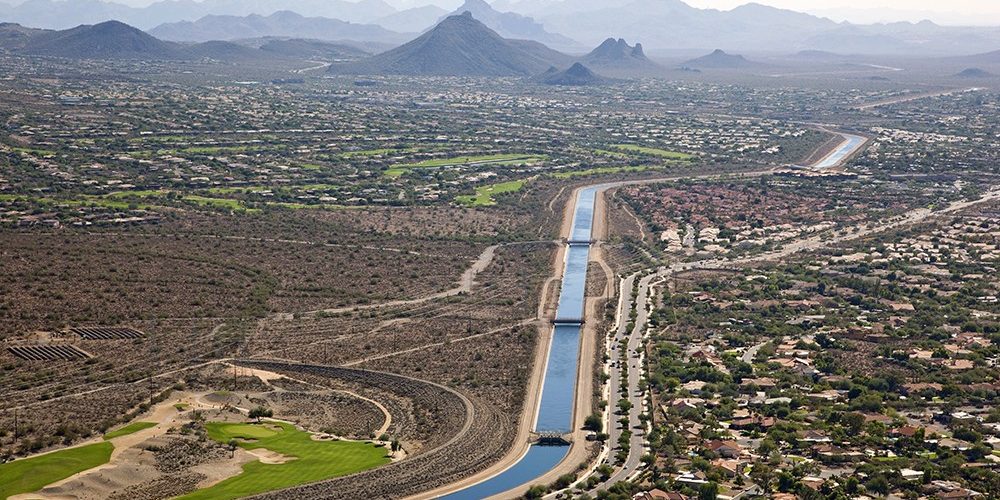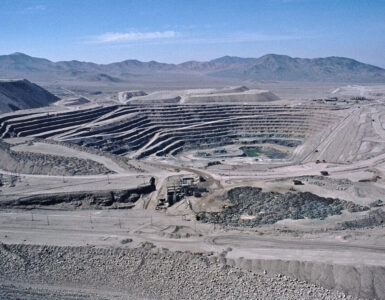Arizona’s top water officials spoke to the manufacturing community Wednesday about what’s being done to protect the state’s water supplies for future growth in this new era of climate change.
In fact, there is the potential for the state to experience its first-ever water shortage next year, they said. A 20-year drought with no end in sight is shrinking the Southwest’s most important water resource, the mighty Colorado River.
For now, there’s enough water to support the state’s blooming industry base, said Tom Buschatzke, the director of the Arizona Department of Water Resources (ADWR), and Ted Cooke, general manager of the Central Arizona Project (CAP), during a virtual “breakfast” meeting of the Arizona Manufacturers Council (AMC), the voice of the manufacturing sector.

Proactive conservation efforts over the past seven years including a seven-state-plus-Mexico drought plan to conserve and share resources have resulted in an extra 40 feet of water in Lake Mead, the “storage tank” for Colorado River supplies, they said.
“In the near term, our residents can be assured that their water supplies are more reliable and secure and the economies and the state supported by this Colorado River can thrive and are more secure,” Bushatzke said.
Potential for state’s first-ever shortage in 2022
That doesn’t mean big challenges don’t lie ahead. But they are nothing new for Arizona, which uses less water today than it did in the 1950s because of new technologies and methods that “get more use out of every drop,” Buschatzke said.
As the Colorado diminishes, Arizona must invest in new technology and innovation and find new resources for water other than the river, they said.
Next year, Arizona is anticipating its first-ever shortage declaration on the Colorado River. The shortage will result in a substantial cut to Arizona’s share of the river, with reductions falling largely to central Arizona agricultural users.
Currently, the river is operating in a “Tier Zero” status, requiring the state to contribute 192,000 acre-feet of Arizona’s 2.8 million acre-foot annual entitlement to Lake Mead. This contribution is coming entirely from the CAP system.
Based on the current hydrology, it is likely that the U.S. Bureau of Reclamation will elevate the shortage level to a “Tier 1” in 2022. This would require Arizona to reduce uses by a total of 512,000 acre-feet, again, borne almost entirely by the CAP system.
Cities and tribes, which are considered “high priority” users when it comes to Colorado River water, will not be affected by the cuts during a Tier 1 shortage. If the state dips into the next lower level, “Tier 2,” cuts to water allocations would be more widespread among users in order to leave water in Lake Mead.
River will continue to be resource for generations to come

While there are “big challenges” ahead and less water coming to Arizona from the Colorado River, it will continue to be a vital source of water for generations to come, said Cooke, of the CAP, which delivers Colorado River water to the populous desert regions in the center of the state including the the Sun Corridor mega region that stretches from metro Phoenix to metro Tucson.
Clock ticking on new drought plan for 2026
With the updated DCP doing its job, Buschatzke and Cooke are once again embarking on the years-long process to renegotiate a new DCP in 2026. They will be working with not only stakeholders within Arizona, but officials in Mexico and the six other Colorado Basin states: California, Colorado, Nevada, New Mexico, Utah, and Wyoming.
As they did in 2019, Buschatzke and Cooke are leading a statewide committee, the new Arizona Reconsultation Committee, to negotiate the new plan. The committee is nearly a carbon copy of the previous 40-member DCP committee. Members include municipal and other water officials, tribes, agricultural groups, homebuilder associations, lawmakers, and the Governor’s Office.
Augmentation council working to find new water supplies
Another committee,the Governor’s Water Augmentation Council, is charged with finding new water resources beyond the Colorado River and targeting conservation projects.
“There’s no silver bullet” but manufacturers can feel confident that Arizona is well prepared for the coming years, Cooke said.
“The important thing to remember is, we have a plan. It’s called the Drought Contingency Plan. Lots of people were involved to make this work and while this plan is being implemented, we’re working on the next plan,” he said.
Follow what’s happening with drought on new website
All of the basin states are struggling with drought. Arizona has seen some level of drought at least since 2002. Last year was the second driest calendar year on record for the state and the driest since 1956.
To better serve stakeholders, decision makers and the public, the National Oceanic and Atmospheric Administration’s National Integrated Drought Information System recently launched a major redesign of Drought.gov.
This one-stop resource has several features including:
- Drought conditions down to the city and county level, including current conditions, key indicators of drought, outlooks and forecasts, water supply impacts, historical drought conditions, and more. You can also access curated lists of drought early warning resources for Arizona and the entire Intermountain West.
- Historical data and maps, including an interactive map where viewers can compare three historical drought datasets side by side down to the county level: U.S. Drought Monitor data going back to 2000, Standardized Precipitation Index (SPI) data going back to 1895, and paleoclimate data from tree-ring analysis going back to the year 0 for some regions of the U.S.
By Sector section, which shows drought impacts on different economic sectors, such as agriculture, energy, water utilities, and tourism and recreation.
















Add comment